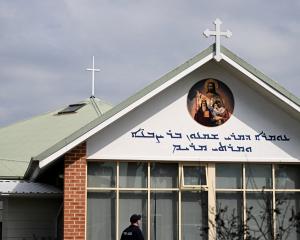The landslide, triggered by heavy rains in Nepal's Sindhupalchowk district, killed at least nine people and buried dozens of homes. More than 100 people are believed missing.
The slide has also created a mud dam blocking the Sunkoshi river, which runs into India's Bihar state as the Kosi river.
Indian officials said water levels were already above the danger mark. They feared that as Nepal blasts through the landslide to clear it, a torrent of water could be unleashed inundating hundreds of Bihar's villages.
"We are repeatedly appealing to villagers settled along the Kosi embankments to flee to safer places as soon as possible," the principal secretary in Bihar's disaster management department, Vyasji, who goes only by one name, told reporters.
"The blasting of blockage in river could result in a 10-metre high wall of water sweeping down Kosi into Bihar which could bring trouble," he added.
The Kosi river remains a key concern for both India and Nepal after it broke its banks in 2008 and changed its course, submerging swathes of land and affecting more than two million people in Bihar. More than 500 people died.
The Nepal army said they had started opening the dam by setting off two controlled blasts and water had started to drain out slowly.
But Indian authorities are taking no chances and have put eight districts under flood alert, and begun evacuations in the districts of Supaul, Madhubani and Saharsa.
Sluice gates at a barrage along the Kosi at the Indo-Nepal border have been opened, rescue teams deployed and over 200 boats sent out to evacuate villagers, said senior officials.
DEATH TOLL MAY RISE
In Nepal, nine bodies were recovered from the debris of dozens of collapsed houses and search and rescue operations were under way.
Police warned the death toll was likely to rise further.
"More than 100 people may still be missing as 50-60 houses are buried according to the accounts of the local people," a police spokesman told Reuters.
Survivors said the mishap happened while they were asleep.
"Everything started falling all of a sudden. I had not seen such a disaster before," Durga Lal Shrestha, who was injured in the landslide, told Reuters TV from his hospital bed in Kathmandu.
Television channels showed part of a forested hill that collapsed and blocked the river.
Witnesses said mud and rocks came crashing down, blocking the river and creating a 3 km-long lake that has inundated part of the Arniko highway that connects Kathmandu with Tibet.
Residents in downstream villages have also been asked to evacuate as the mud dam could collapse at any time.
"The landslide has caused huge damage. We cannot make any estimates of the number of deaths now. We are looking for other people who might be trapped," police officer Bharat Bahadur Bohara told Reuters from the site.
Monsoon rains that start in mid-June and continue through September are crucial for many countries in South Asia. Yet scores of people die every year in landslides and floods.
Heavy rains in June last year caused rivers and lakes to burst their banks, killing almost 6,000 people in the Indian state of Uttarakhand.












